
Extractos del catálogo
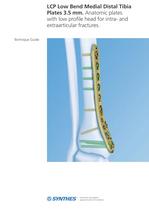
LCP Low Bend Medial Distal Tibia Plates 3.5 mm. Anatomic plates with low profile head for intra- and extraarticular fractures. Technique Guide
Abrir la página 1 del catálogo
Introduction LCP Low Bend Medial Distal Tibia Plates 3.5 mm 2 Surgical Technique Preparation 6 Product Information Set Lists 17 Image intensifier control This description alone does not provide sufficient background for direct use of the instrument set. Instruction by a surgeon experienced in handling these nstrument is highly recommended Reprocessing, Care and Maintenance of Synthes Instruments For general guidelines, function control and dismantling of multipart instruments please refer to: www.synthes.com/reprocessing
Abrir la página 3 del catálogo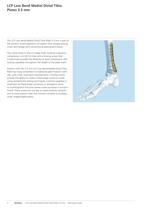
LCP Low Bend Medial Distal Tibia Plates 3.5 mm The LCP Low Bend Medial Distal Tibia Plate 3.5 mm is part of the Synthes Small Fragment LCP system that merges locking screw technology with conventional plating techniques. The combi-holes in the LCP plate shaft combine a dynamic compression unit (DCU) hole with a locking screw hole. Combi-holes provide the flexibility of axial compression and locking capability throughout the length of the plate shaft. Fixation with the 3.5 mm LCP Low Bend Medial Distal Tibia Plate has many similarities to traditional plate fixation methods, with a few...
Abrir la página 4 del catálogo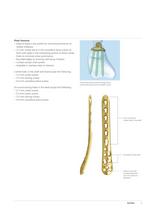
Plate features – Head of plate is low profile for minimal prominence on medial malleolus – 3.5 mm cortex and 4.0 mm cancellous bone screws sit flush with plate in the nonlocking portion of distal combiholes to minimize screw prominence – Rounded edges to minimize soft tissue irritation – Limited-contact shaft profile – Available in stainless steel or titanium Combi-holes in the shaft and head accept the following: – 3.5 mm cortex screws – 3.5 mm locking screws – 4.0 mm cancellous bone screws Three distal locking screws diverge across subchondral bone and are parallel to joint Six round...
Abrir la página 5 del catálogo
AO Principles In 1958, the AO formulated four basic principles, which have become the guidelines for internal fixation.1,2 Those principles, as applied to the 3.5 mm LCP Low Bend Medial Distal Tibia Plate, are: Anatomic reduction Precontoured plate assists reduction of metaphysis to diaphysis and facilitates restoration of the articular surface by exact screw placement. Stable fixation Locking screws create a fixed-angle construct, providing angular stability. Preservation of blood supply Tapered end allows submuscular plate insertion, preserving tissue viability. Limited-contact plate...
Abrir la página 6 del catálogo
Indications The Synthes LCP Low Bend Medial Distal Tibia Plates are intended for fixation of complex intra- and extra-articular fractures and osteotomies of the distal tibia, as a part of the Synthes Small Fragment LCP System. Synthes 5
Abrir la página 7 del catálogo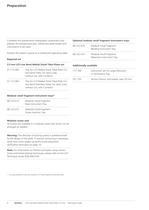
Complete the preoperative radiographic assessment and prepare the preoperative plan. Determine plate length and Position the patient supine on a radiolucent operating table. 3.5 mm LCP Low Bend Medial Distal Tibia Plates set 01.1 12.062 Tray for LCP Medial Distal Tibial Plate 3.5, low bend (TAN), for Vario Case, without Lid, with Contents 01.1 12.063 Tray for LCP Medial Distal Tibial Plate 3.5, low bend (Stainless Steel), for Vario Case, without Lid, with Contents Modular small fragment instrument trays* 68.122.013 Modular Small Fragment Basic Instrument Tray 68.122.015 Modular Small...
Abrir la página 8 del catálogo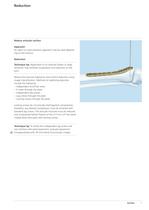
Reduction Reduce articular surface Approach An open or a percutaneous approach may be used depending on the fracture. Reduction Technique tip: Application of an external fixator or large distractor may facilitate visualization and reduction of the joint. Reduce the fracture fragments and confirm reduction using image intensification. Methods of stabilizing reduction include the following: – Independent Kirschner wires – K-wires through the plate – Independent lag screws – Lag screws through the plate – Locking screws through the plate Locking screws do not provide interfragment compression;...
Abrir la página 9 del catálogo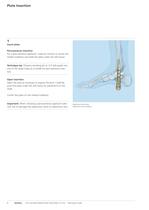
Plate Insertion Insert plate Percutaneous insertion For a percutaneous approach, make an incision to access the medial malleolus and slide the plate under the soft tissue. Technique tip: Thread a bending pin or LCP drill guide into one of the distal holes as a handle for percutaneous inser- Open insertion Open the area as necessary to expose the joint. Carefully push the plate under the soft tissue for placement on the Center the plate on the medial malleolus. Important: When choosing a percutaneous approach take care not to damage the saphenous nerve or saphenous vein. Saphenous vein...
Abrir la página 10 del catálogo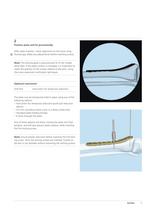
2 Position plate and fix provisionally After plate insertion, check alignment on the bone using fluoroscopy. Make any adjustments before inserting screws. Note: This locking plate is precontoured to fit the medial distal tibia. If the plate contour is changed, it is important to check the position of the screws relative to the joint, using the screw placement verification technique. Optional instrument 324.024 Instrument for temporary reduction The plate may be temporarily held in place using any of the following options: – Instrument for temporary reduction (push-pull reduction device) –...
Abrir la página 11 del catálogo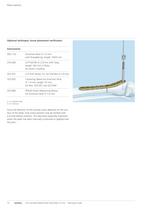
Plate Insertion Optional technique: Screw placement verification with threaded tip, length 1 50/5 mm 310.284 LCP Drill Bit 0 2.8 mm with Stop, 323.027 LCP Drill Sleeve 3.5, for Drill Bits 0 2.8 mm 323.055 Centering Sleeve for Kirschner Wire 323.060 PHILOS Direct Measuring Device Since the direction of the locking screw depends on the con- tour of the plate, final screw position may be verified with a K-wire before insertion. This becomes especially important when the plate has been manually contoured or applied near Synthes LCP Low Bend Medial Distal Tibia Plates 3.5 mm Technique Guide
Abrir la página 12 del catálogo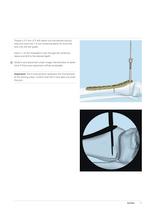
Thread a 3.5 mm LCP drill sleeve into the desired locking hole and insert the 1.6 mm centering sleeve for Kirschner wire into the drill guide. nsert a 1.6 mm threaded K-wire through the centering sleeve and drill to the desired depth. O Verify K-wire placement under image intensification to deter- mine if final screw placement will be acceptable. Important: The K-wire position represents the final position of the locking screw. Confirm that the K-wire does not enter
Abrir la página 13 del catálogoTodos los catálogos y folletos técnicos Depuy Synthes
-
2.0 mm LCP® Distal Ulna Plate
20 Páginas
-
VA LCP ® Distal Radius System
8 Páginas
-
Building on Success
16 Páginas
-
RADIUS OF CURVATURE
3 Páginas
-
Introducing The Variable Angle
12 Páginas
-
HEALIX Anchor™ 3.4 mm
2 Páginas
-
Small Battery Drive II
4 Páginas
-
HEALIX ADVANCE
4 Páginas
-
3.5 mm LCP™ Medial
15 Páginas
-
Titanium Sternal Fixation System
34 Páginas
-
MatrixRIB®FixationSystem
86 Páginas
-
External Midface Distractor System
43 Páginas
Catálogos archivados
-
2.4 mm VA LCP™
4 Páginas
-
Mandible Trauma Solutions
2 Páginas
-
Power line II
4 Páginas
-
Concorde
28 Páginas
-
LCP Intercarpal
31 Páginas
-
LCS® COMPLETE™
2 Páginas
-
Cementing Total Knee Replacements
12 Páginas
-
CORAIL® Hip System Design Rationale
12 Páginas
-
Synthes TPLO.
8 Páginas
-
SynFix-LR System
56 Páginas
-
ATB Anterior Tension Band Plate
32 Páginas
-
CONDUIT™
15 Páginas
-
Brochure_FINAL
2 Páginas
-
DePuy Synthes
81 Páginas
-
Anspach
3 Páginas
-
Orthopedic Foot Instruments
32 Páginas
-
PINNACLE® Hip Solutions
12 Páginas
-
Corail
24 Páginas
-
GLOBAL Advantage Surgical Technique
32 Páginas
-
S-ROM® NOILES™
68 Páginas
-
TRI-LOCK® Product Rationale
12 Páginas
-
Reclaim Surgical Technique
44 Páginas
-
DESIGN RATIONALE AND SURGICAL TECHNIQUE
28 Páginas
-
PRODUCT RATIONALE AND SURGICAL TECHNIQUE
32 Páginas
-
Speed
2 Páginas
-
attune
80 Páginas
-
HAMMERLOCK® 2
2 Páginas
-
DePuy Glenoid Solutions
2 Páginas
-
Trauma Solutions. Elbow
4 Páginas
-
Polar
4 Páginas
-
Alveolar Distractor.
4 Páginas
-
Piezoelectric System
4 Páginas
-
Air Power Line II
6 Páginas
-
LCP Clavicle Hook Plate
4 Páginas
-
TruMatch Pin Guides
16 Páginas
-
P F N A
8 Páginas
-
SKILL, DEDICATION,
16 Páginas
-
Orthopaedics. Overview
20 Páginas
-
DURALOC
16 Páginas
-
Marathon Cemented Cup
20 Páginas
-
REEF Surgical Technique
16 Páginas
-
MatrixNEURO
8 Páginas
-
Anspach XMax
4 Páginas
-
Anspach eMax 2 Plus
4 Páginas
-
Small Electric Drive
4 Páginas
-
Air Pen Drive
4 Páginas
-
Colibri II
4 Páginas
-
Spine
25 Páginas
-
Epoca Shoulder Arthroplasty System
8 Páginas
-
VA-LCP Elbow Plating System Promotional
12 Páginas
-
MultiLoc Humeral Nailing System.
4 Páginas
-
Headless Compression Screws 4.5 & 6.5
28 Páginas
-
Expert Hindfoot Arthrodesis Nail
48 Páginas
-
LCP Distal Fibula Plates
32 Páginas
-
TomoFix
60 Páginas
-
Expert Tibial Nail PROtect
16 Páginas
-
Expert Tibia Nail
84 Páginas
-
Sacral Bars
16 Páginas
-
Pelvic C-Clamp
20 Páginas
-
Low Profile Pelvic System
16 Páginas
-
Proximal Femoral (Hook) Plate
24 Páginas
-
LCP
24 Páginas
-
PFNA
112 Páginas
-
HCS 1.5, 2.4, 3.0
36 Páginas
-
LCP Wrist Fusion
32 Páginas
-
LCP Compact Hand
28 Páginas
-
VA-LCP Elbow
48 Páginas
-
Distal Radius
44 Páginas
-
Olecranon
30 Páginas
-
LCP Hook Plate
28 Páginas
-
DHP & Olecranon
4 Páginas
-
LCP S-A
4 Páginas
-
Epoca
4 Páginas
-
Philos
32 Páginas
-
MultiLoc
68 Páginas









































































































